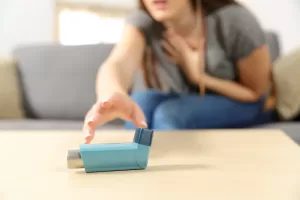How to treat an Asthma Attack
Medically Reviewed by Dr Ali Zavery
Last updated on 11.06.2024
A severe asthma attack can be a very frightening experience both for the person themselves, and for those caring for them. During winter, when more respiratory viruses are circulating, and in certain weather conditions (such as thunderstorms or bushfires), large numbers of people may get asthma attacks at the same time, placing extra pressure on ambulance and hospital services. So, it’s good for us all to know asthma first aid, and for asthma sufferers to have a clear idea of their own asthma action plan.
What are the symptoms of an asthma attack?
An asthma flare-up can come on gradually over hours or days, or more suddenly over a few minutes. A severe or sudden flare up of asthma symptoms is also referred to as an “asthma attack”.
Mild to Moderate Asthma
A mild to moderate asthma flare -up usually presents as minor breathing difficulty or chest tightness, sometimes with a cough or wheeze- but it is still possible to move around and speak in full sentences without a problem. The first steps in asthma first aid should be started (see below), to prevent symptoms from getting worse.
Severe Asthma
Symptoms of a severe asthma attack or flare-up include:
- Obvious difficulty breathing
- Unable to speak a full sentence in a single breath
- Cough and wheeze may be present (but not always)
- The person’s usual “reliever” inhaler is not working as well as usual
- Tiredness or exhaustion from the effort of trying to breathe properly
If someone appears to have severe asthma, call Triple Zero 000, and ask for an ambulance. Asthma first aid should ALSO be started (see below)
Life-threatening Asthma
Symptoms of a life-threatening asthma attack include:
- Gasping for breath, only able to get a few words between breaths
- Looking pale or blue
- Collapsing/fainting/exhausted
- A person’s usual reliever inhaler is not working
- Confusion
- Sometimes the wheeze and cough may actually seem to get better , but this can be because the person is weakening, and the muscles used for breathing and coughing are able to make less of an effort.
If these symptoms occur, call Triple Zero 000 and ask for an ambulance AND start asthma first aid (see below)
Asthma First Aid- how to treat an asthma attack:
- Sit the person upright. Try to keep them calm, and stay with them.
- Give 4 individual puffs of reliever inhaler ( this is usually a blue or grey puffer- ask them!)
- You shake the puffer, and spray 1 puff ideally into a spacer device (if the person has one) and the person takes 4 breaths via the spacer.
- Do this 4 times in total. So it’s SHAKE, 1 PUFF, 4 BREATHS- do this 4 times.
- If you don’t have a spacer, give 1 puff as they take 1 slow, deep breath and hold this breath for as long as comfortable. Repeat until all 4 puffs are taken.
- After this, you wait 4 minutes (time it). If no improvement, give 4 more puffs the same way as before.
- If still no improvement call Triple Zero 000 (unless you’ve already done so) – ask for an ambulance, say it is an asthma emergency.
- Keep giving 4 puffs every 4 minutes till the ambulance arrives.
What if you’re unsure if someone is having an asthma attack?
If it looks like someone is having an asthma attack, you can still use a blue reliever medication in this situation, because it is unlikely to cause harm. For example, sometimes, during thunderstorms, people who do not normally get asthma may get asthma attacks.
What if someone is having an asthma attack and there’s no reliever medication available?
Always call triple zero (000) immediately if someone is having an asthma attack and there’s no reliever medication available.

What are some other asthma situations when I should call Triple 000?
Always call an ambulance/call 000 if:
- a person is not breathing
- the person is unsure if it is asthma, but it looks like they are having an asthma attack
- a person’s asthma suddenly gets worse or is not improving with first aid steps
- a person who has asthma and who is also known to have anaphylaxis (to food, insects or medication etc) develops sudden breathing difficulty. In this case, ALWAYS GIVE ADRENALINE AUTOINJECTOR FIRST, and then the asthma reliever puffer afterwards, even if there are no obvious skin symptoms of allergy/anaphylaxis.
If you have more questions about asthma management or developing an asthma action plan, speak to your doctor.
If your child needs an asthma action plan renewed for school, you can discuss with Qoctor- start HERE.
Further Patient Resources
Getting a Mental Health Care Plan in Australia: Your Guide
Getting a Mental Health Care Plan in Australia: Your Guide Mental health matters—and if you’re feeling overwhelmed, anxious, or down, a mental health care plan can help. But what is it, and how do [...]
UTI Symptoms and Treatment: What You Need to Know
UTI Symptoms and Treatment: What You Need to Know Urinary Tract Infections (UTIs) are common, uncomfortable, and often disruptive. But what exactly are the signs to watch for, and how can you get relief [...]
Free Mental Health Care Plan Online | Bulk-Billed by Qoctor
Free Mental Health Care Plan Online | Bulk-Billed by Qoctor Discover how to get a free, bulk-billed Mental Health Care Plan (MHCP) in Australia through Qoctor's telehealth service. Accessing [...]





